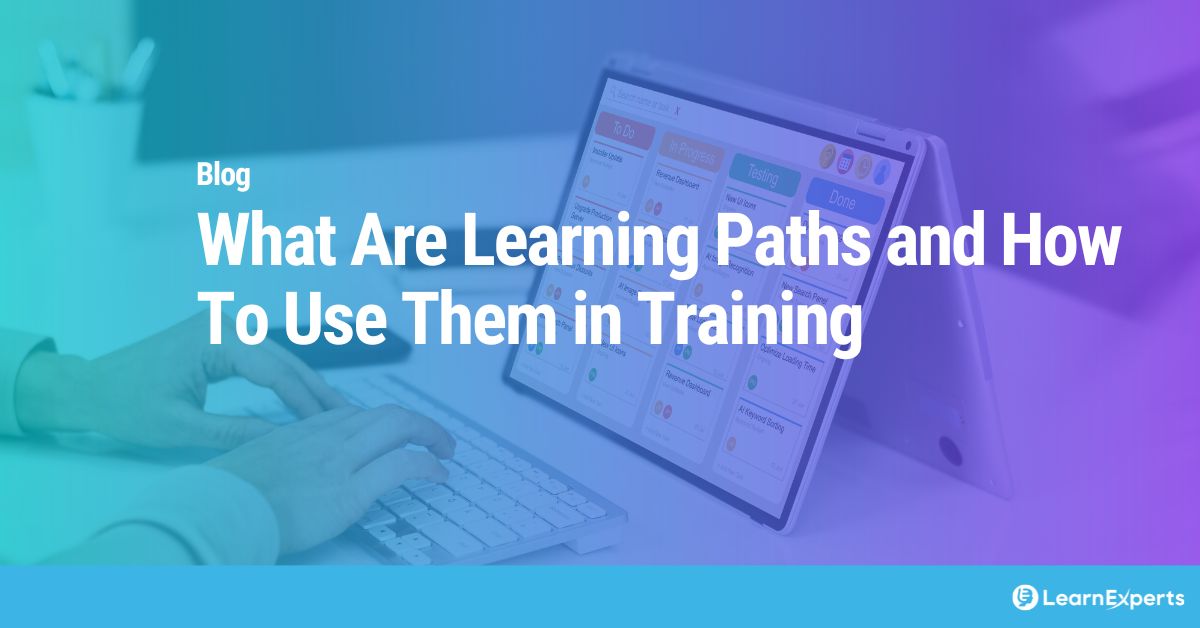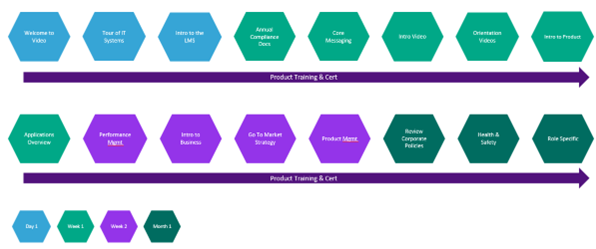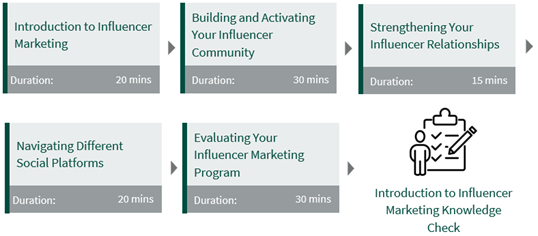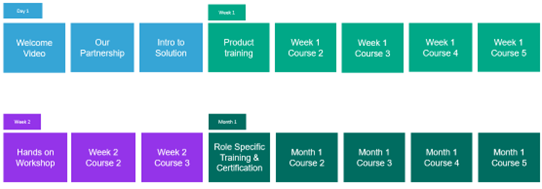In today’s fast-paced business environment, organizations are increasingly focusing on structured learning and development to ensure their employees are equipped with the right skills to grow and succeed. One of the most effective ways to facilitate this development is through the use of learning paths—a strategic approach to organizing training and educational content in a way that guides learners through a clear progression of knowledge and skills.
What are learning paths?
Learning paths, also known as learning tracks, training paths or learning journeys, are structured and curated educational resources and activities designed to help individuals achieve specific learning goals or acquire certain skills and knowledge. These paths are typically tailored to a particular learner role, subject, field, or domain and are intended to guide learners through a systematic and progressive learning process.
Training paths also offer an organized and focused approach to learning, as they break down complex topics into smaller, manageable steps. The sequence of courses, resources and activities in a learning path is often carefully designed to ensure learners build a solid foundation before moving on to more advanced concepts.
In this blog, we will discuss common topics related to learning paths and how to include them in training, learning, and development programs.
How to plan learning tracks
Learning paths can cover various topics, from technical skills like programming languages and data analysis to soft skills like communication and leadership. Well-structured learning paths make efficient use of learning time and help learners stay motivated as they progress towards their learning goals.
Designing an effective learning path involves careful planning to ensure learners achieve their desired outcomes efficiently and meaningfully. Here are some steps to help you design an effective learning path:
- Conduct a training needs analysis: Identify the target audience, learning goals, and current skill level of learners.
- Build learning objectives: Ensure that the objectives are specific, measurable, achievable, relevant, and time-bound (SMART).
- Analyze your audience: Understand the target audience’s current knowledge, skill level, and learning preferences.
- Choose the right content: Select high-quality learning materials that align with the learning objectives and considers their current knowledge, skill level and learning styles.
- Group the content: Organize the content into consumable chucks that will fit best with the target audience’s schedule and work best with the modality of the learning. For example, for self-paced eLearning you typically want to allow learners to fit it easily into their existing work schedule, so modules should be 30 minutes or less, whereas a more traditional instructor-led in-person training is typically longer to make the best use of the instructor and learners’ time.
- Sequence the content: Organize the content in a logical and progressive order by starting with foundational concepts and gradually move to more advanced topics.
How AI helps personalize learning journeys
Key features of good learning paths
There are three types of learning paths: successive, alternative, and level. In a successive learning path, learners must follow a structured route of courses, complete every course or module, and progress to the next course only after completing the pre-requisite courses.
With alternative learning pathways, learning paths focus on achieving the learning outcomes rather than the learning order. Learners can skip optional chapters or lessons but must complete the mandatory courses. It allows learning choices without compromising the learning objectives.
A level learning path combines successive and alternative learning paths by creating hierarchies, where each level consists of a bundle of mandatory and/or optional courses. It may or may not have a stipulated time frame.
Regardless of the type, well-designed learning journeys should typically include:
- Clear objectives: Let learners know what they will achieve upon track completion.
- Chunking and microlearning: Break down the learning content into smaller, manageable chunks. Microlearning modules or bite-sized lessons help learners focus on specific topics, enhance retention, and make learning more accessible.
- Real-world applications: Connect theoretical concepts to real-world applications to demonstrate the practical relevance. Allow learners to apply their learning.
- Diverse resources: Include videos, articles, quizzes, interactive exercises, hands-on projects, group projects, and discussion forums to increase interest and engagement.
- Assessment and feedback: Include exercises and quizzes to help learners gauge their progress and understanding.
- Personalization and flexibility: Offer options for different learning styles, paths, or formats.
- Motivation and rewards: Incorporate gamification, rewards, and/or recognition (badges, leaderboards, etc.), to keep learners motivated and engaged.
- Progress tracking and communication: Track the learner’s progress through the learning path and provide updates and reminders to ensure learners stay on track.
Examples of learning tracks
Here are a few examples of learning paths for different subjects or skills:
Introduction to Programming:
- Module 1: Introduction to Programming Concepts
- Module 2: Variables and Data Types
- Module 3: Control Structures (Conditionals and Loops)
- Module 4: Functions and Modular Programming
- Module 5: Arrays and Lists
- Module 6: Object-Oriented Programming Basics
- Module 7: File Handling and Input/Output
- Module 8: Introduction to Algorithms and Problem Solving
- Module 9: Introduction to Web Development (HTML, CSS)
Learning a Musical Instrument (Piano):
- Module 1: Introduction to Piano and Basic Music Theory
- Module 2: Hand Positioning and Finger Exercises
- Module 3: Reading Sheet Music and Rhythm Basics
- Module 4: Playing Chords and Accompaniment Patterns
- Module 5: Melody Playing and Sight-Reading
- Module 6: Music Scales and Key Signatures
- Module 7: Playing Classical Music Pieces
- Module 8: Improvisation and Music Interpretation
- Module 9: Performing in Ensembles or Bands
You can also represent your learning paths visually, which is an even better way to communicate the paths to your learners and, here are some examples:
Introduction to Influencer Marketing:
Partner Enablement:
Let us help you with learning paths
Learning paths are an essential component of training programs that we build or help our clients build. It ensures that your audience has a clear path to build their knowledge and/or skills in a logical flow that starts with building foundational skills or concepts and builds more complexity on those as the program progresses. In essence, training paths lead your audience through the learning content in a prescriptive way to optimize their retention of the materials.
In addition to accelerating the course content creation process, our content creation platform LEAi also enables you to organize it into learning paths to create effective learning programs for your audiences. So, what are you waiting for? Let us help you get your learning programs created fast!







